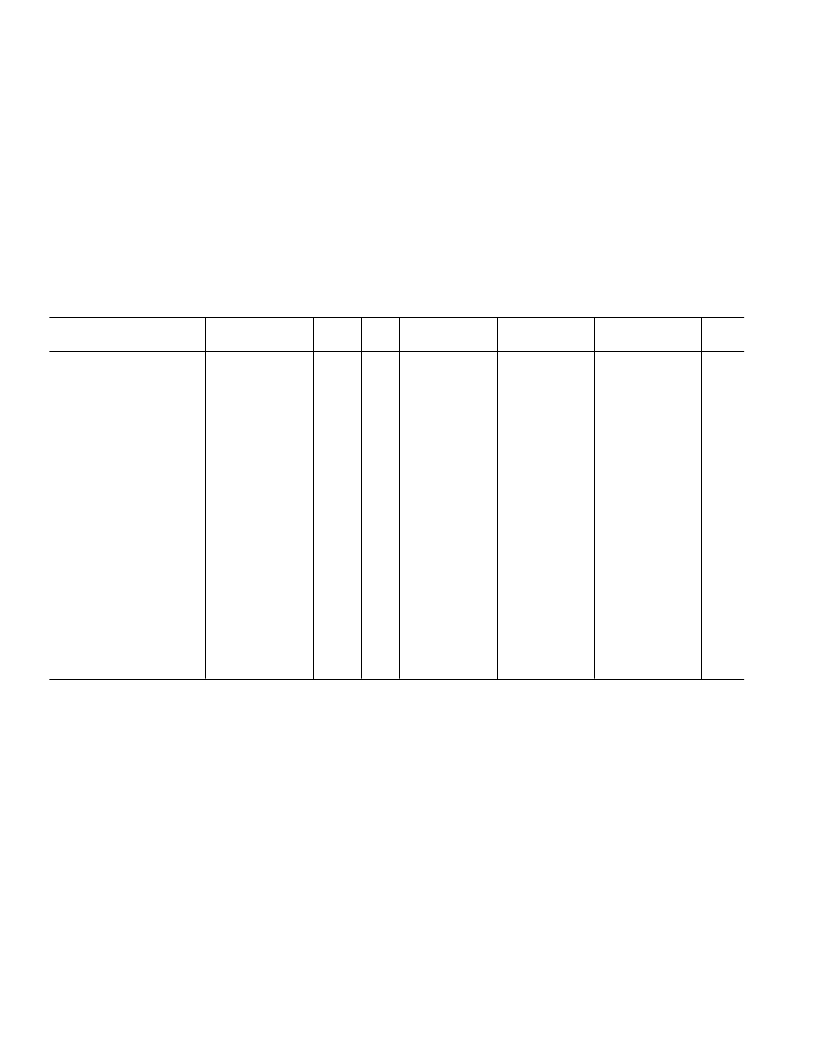- 您現在的位置:買賣IC網 > PDF目錄373964 > AD9617JN (ANALOG DEVICES INC) Low Distortion, Precision, Wide Bandwidth Op Amp PDF資料下載
參數資料
| 型號: | AD9617JN |
| 廠商: | ANALOG DEVICES INC |
| 元件分類: | 運動控制電子 |
| 英文描述: | Low Distortion, Precision, Wide Bandwidth Op Amp |
| 中文描述: | OP-AMP, 2200 uV OFFSET-MAX, PDIP8 |
| 封裝: | PLASTIC, DIP-8 |
| 文件頁數: | 2/10頁 |
| 文件大小: | 140K |
| 代理商: | AD9617JN |

–2–
REV. B
AD9617–SPECIFICATIONS
DC ELECTRICAL CHARACTERISTICS
Test
Level
AD9617JN/JR
Min
Typ
AD9617AQ/SQ*
Min
Typ
AD9617BQ/TQ*
Min
Typ
Parameter
Conditions
Temp
Max
Max
Max
Units
Input Offset Voltage
1, 2
Input Offset Voltage TC
2
Input Bias Current
2
Inverting
Noninverting
Input Bias Current TC
2
Noninverting
Inverting
Input Resistance
Noninverting
Input Capacitance
Noninverting
Common-Mode Input Range
3
+25
°
C I
Full
–1.1
–4
+0.5
+3
+2.2
+25
–1.1
–4
+0.5
+3
+2.2
+25
+0.0
–4
+0.5
+3
+1.35 mV
+25
IV
μ
V/
°
C
+25
°
C I
+25
°
C I
–50
–25
0
+5
+50
+35
–50
–25
0
+5
+50
+35
–25
–15
0
+5
+25
+20
μ
A
μ
A
Full
Full
IV
IV
–50
–50
+30
+50
+125 –50
+150 –50
+30
+50
+125
+150
–50
–50
+30
+50
+125
+150
nA/
°
C
nA/
°
C
+25
°
C V
60
60
60
k
+25
°
C V
←
←
←
←
Full
1.5
±
1.5
±
1.8
48
51
51
1.5
±
1.5
±
1.8
48
51
51
1.5
±
1.5
±
1.8
48
51
51
pF
V
V
dB
dB
dB
T = T
MAX
T = T
MIN
to +25
°
C
T = T
MIN
to T
MAX
T = T
MIN
to +25
°
C
V
S
=
5%
II
II
II
II
II
±
1.4
±
1.7
44
48
48
±
1.4
±
1.7
44
48
48
±
1.4
±
1.7
44
48
48
Common-Mode Rejection Ratio
4
Power Supply Rejection Ratio
Open Loop Gain
T
Nonlinearity
Output Voltage Range
Output Impedance
Output Current (50
Load)
At DC
At DC
+25
°
C V
+25
°
C IV
+25
°
C II
+25
°
C V
←
←
500
10
±
3.8
0.07
500
10
±
3.8
0.07
500
10
+3.8
0.07
k
ppm
V
mA
mA
±
3.4
±
3.4
±
3.4
At DC
T = +25
°
C to T
MAX
T = T
MIN
II
II
60
50
60
50
60
50
NOTES
*Pending obsoletion: last-time buy October 25, 1999.
1
Measured with respect to the inverting input.
2
Typical is defined as the mean of the distribution.
3
Measured in voltage follower configuration.
4
Measured with V
IN
= +0.25 V.
Specifications subject to change without notice.
ABSOLUTE MAXIMUM RATINGS
1
Supply Voltages (
±
V
S
) . . . . . . . . . . . . . . . . . . . . . . . . . . . +7 V
Common-Mode Input Voltage . . . . . . . . . . . . . . . . . . . . .
±
Vs
Differential Input Voltage . . . . . . . . . . . . . . . . . . . . . . . . . 3 V
Continuous Output Current
2
. . . . . . . . . . . . . . . . . . . . . 70 mA
Operating Temperature Ranges
AD9617JN/JR . . . . . . . . . . . . . . . . . . . . . . . . 0
°
C to +70
°
C
Storage Temperature
AD9617JN/JR . . . . . . . . . . . . . . . . . . . . . –65
°
C to +125
°
C
Junction Temperature
3
AD9617JN/JR . . . . . . . . . . . . . . . . . . . . . . . . . . . . . +150
°
C
Lead Soldering Temperature (10 Seconds) . . . . . . . . . +300
°
C
NOTES
1
Absolute maximum ratings are limiting values to be applied individually and
beyond which the serviceability of the circuit may be impaired. Functional
operability is not necessarily implied. Exposure to absolute maximum rating
conditions for an extended period of time may affect device reliability.
2
Output is short circuit protected to ground, but not to supplies. Continuous
short circuit to ground may affect device reliability.
3
Typical thermal impedances (part soldered onto board):
Plastic DIP:
θ
JA
= 140
°
C/W;
θ
JC
= 30
°
C/W. SOIC Package:
θ
JA
= 155
°
C/W;
θ
JC
= 40
°
C/W.
(Unless otherwise noted, A
V
= +3;
6
V
S
=
6
5 V; R
F
= 400
V
; R
LOAD
= 100
V
)
相關PDF資料 |
PDF描述 |
|---|---|
| AD9617JR | Low Distortion, Precision, Wide Bandwidth Op Amp |
| AD9618 | ECONOLINE: REC3-S_DRW(Z)/H4,H6 - Safety standards and approval: EN 60950 certified, rated for 250VAV (LVD test report)- Applied for Ul 1950 Component Recognised Certification- 3W DIP Package- 4kVDC & 6kVDC Isolation- Regulated Output- Continuous Short Circiut Protection Auto-Restarting |
| AD9618AQ | Low Distortion, Precision, Wide Bandwidth Op Amp |
| AD9618BQ | Low Distortion, Precision, Wide Bandwidth Op Amp |
| AD9618JR | Low Distortion, Precision, Wide Bandwidth Op Amp |
相關代理商/技術參數 |
參數描述 |
|---|---|
| AD9617JR | 制造商:Analog Devices 功能描述:Operational Amplifier, Single AMP, Bipolar, 8 Pin, Plastic, SOP |
| AD9617JR-REEL | 制造商:AD 制造商全稱:Analog Devices 功能描述:Low Distortion, Precision, Wide Bandwidth Op Amp |
| AD9617SQ | 制造商:未知廠家 制造商全稱:未知廠家 功能描述:Current-Feedback Operational Amplifier |
| AD9617SQ/883B | 制造商:未知廠家 制造商全稱:未知廠家 功能描述:Current-Feedback Operational Amplifier |
| AD9617SZ | 制造商:未知廠家 制造商全稱:未知廠家 功能描述:Current-Feedback Operational Amplifier |
發布緊急采購,3分鐘左右您將得到回復。